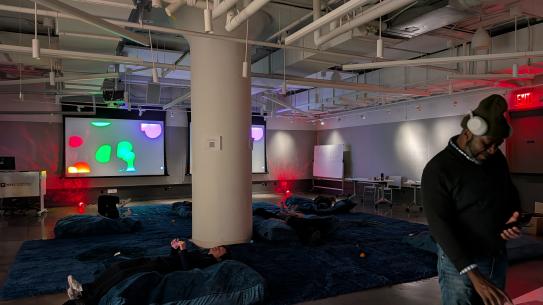Maurizio Porfiri: Three Years Later, Still Brilliant
In 2010, assistant professor Maurizio Porfiri became the first member of the NYU-Poly faculty to earn a coveted spot on Popular Science magazine’s annual roundup of the most promising young scientists, the Brilliant 10. And while he’s no longer alone on the list—assistant professor Justin Cappos is among the 2013 Brilliant 10—his work still lives up to the accolade. Recognized for his experiments using bioinspired robotic fish to understand and influence collective behavior, the so-called “Water Wizard” has spent the past three years building bigger and better robots, and applying the wisdom gleaned from wildlife to better understand a different species—humans.
Porfiri’s latest work applies his expertise in collective animal behavior and systems science— the study of complex, interconnected systems such as those in nature—to a subject that seemingly couldn’t be farther from schooling fish: alcohol-related traffic deaths.
In partnership with professors at NYU’s Steinhardt School of Culture, Education and Human Development, Porfiri is engaged in a NIAAA-funded study of how an understanding of herd behavior may aid policymakers in formulating more effective policies to reduce alcohol-related fatalities. “We know that the activity of one animal in a herd or one fish in a school can influence others—in this case, we’re looking at how states create their drunk driving policies, which vary widely, and how neighboring states’ policies may influence each other,” Porfiri said.
The robots that are now synonymous with his work remain a major focus for Porfiri, who is now in his second year of work on Brooklyn Atlantis, a citizen-science project engaging everyday individuals in the monitoring and cleanup of Brooklyn’s famously polluted Gowanus Canal. Porfiri’s submersible robot has snapped hundreds of thousands of photographs of wildlife, debris and other structures in the canal, many of which will be identified and tagged by volunteer citizen scientists, painting a minute-by-minute account of the Canal’s changing conditions. Never one to overlook the impact of collective behavior, Porfiri is forever honing the workings of Brooklyn Atlantis. “This is a group-driven project,” he said. “If we can find ways to make the interface more interesting, make the robot more exciting, people will engage more and provide more robust data.”
Porfiri also has plans—and National Science Foundation funding—to build a larger, more intricate version of the robotic fish featured in his experiments. This one won’t live in a lab, however. Instead, it will take up residence alongside its real-life inspiration at the New York Aquarium in Coney Island. “This robot will have a whole infrastructure, and visitors will be able to use an iPad or iPod to control its movements,” Porfiri said. “We’re always looking for ways to ignite interest in science.”



